I’ve been writing about film cameras for a long time now, but the release of a new film camera from a major brand like Pentax feels somehow more significant than most, if not all that I’ve written about before. The Pentax 17 is not only a completely new film camera, it seems to be the start of a new era of film cameras from Pentax, and I can’t help but be quite excited by that prospect.
The Film Camera Marketplace
Since I started running this website, the film camera marketplace has been largely dominated by secondhand sales. There’s just so many cameras to choose from that were made over the last hundred-plus years, that it’s almost felt like there’s no need for a new film camera. After all, most film cameras have been discontinued since 2012-13 when the film photography industry bottomed out, and we’ve been doing fine surviving on ever-ageing gear for over a decade just fine since then… … right?
Well, also since then – it will come as no surprise to most people reading this – there has been something of a resurgence in film photography. We have seen both Ilford/Harman and Kodak bring new films to market, not to mention all the fringe stuff and rebrands. To be fair, there’s also been loads of new film cameras from cottage industry companies the likes of Intrepid, Chroma, Alfie and the rest who’ve been working away bringing relatively small numbers of cameras to the marketplace. Of course, it would be remiss not to mention Lomography and Leica who have also continued to bring new mass-produced film cameras to production too.
But whatever these brands release new, it’s had very little impact on the used value of secondhand film cameras, many of which have skyrocketed in many cases beyond sensible levels. When I started this website, you could buy pretty much any of the older M-mount Leicas for about £300, even an M6 could be had for about £5-600. I bought my first Contax T2 for £160 and remember at the time dreaming of buying a T3 which felt out of reach at about £500 (I think that’s about what I eventually paid). Search eBay for these cameras now and you’ll see they have doubled, tripled, even quadrupled in value. They’ve got older too, and less reliable with it. I now buy terminally-broken Contax Ts and T2s (to harvest their lenses) for more than I paid for my first working T2.
Yet despite this, none of the major manufacturers have seemingly been interested in bringing anything to market to compete with the used market. Like I said, Lomography have, but much of what they have produced is toy-like, and lower priced. And Leica have, but well, who’s got a spare £5k these days…? What’s felt conspicuously missing from the market place is a few well built, well specified, reasonably priced, and most importantly new cameras – cameras that can be bought without the need for a remortgage, and can be trusted to work, (come with a warranty in case they don’t) and take consistently good photos.
This for me, has always presented a bit of a problem for the film photography industry. Yes, for those of us who know what we’re looking at and what we are doing, buying used cameras is easy. But for someone coming into film for the first time, the lack of new cameras that fit my description above presents a barrier to entry. The amount of times I have been asked the question “what film camera should I buy?” over the years, and I have had to caveat every answer to every beginner by suggesting that they buy from a bricks and mortar shop that will help them, or at very least seek assistance off someone locally to them to help find a working one. In short, I’ve never accepted the idea that there’s enough secondhand cameras out there to mean we don’t need new ones. We do, and we have ever since the big brands stopped making them.
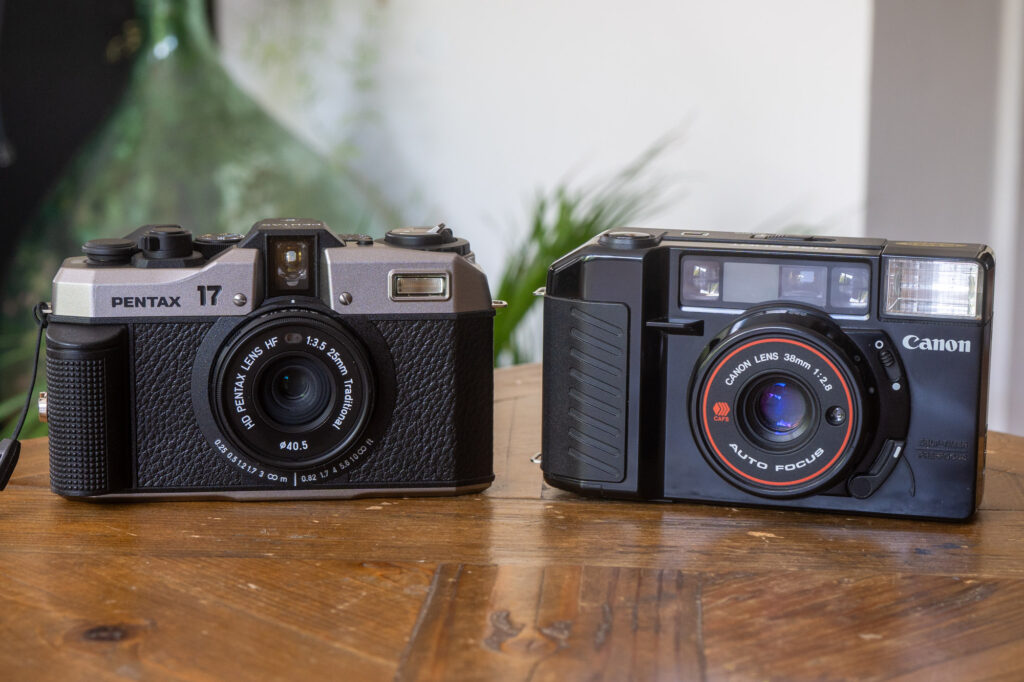
“It’s Time for Film!”
Which is why, after many years of rumours, I am so pleased to finally have my hands on a brand new, reasonably priced film camera from Pentax. Am I surprised it’s Pentax who, out of all of the big brands, have pulled this off first? Not really. If you had asked me a few years ago, I might have put my money on Fuji, but with Pentax (/Ricoh) concentrating on more niche markets such as DSLRS, monochrome digital cameras, large sensor compacts and rugged cameras, they feel like a good fit… probably a better fit than Fuji seeing as they have discontinued so many films too. And of course, that’s even before you consider Pentax’s rich history of making really nice consumer-level film cameras! Though, I do feel the need to cast a little bit of shade over the slightly, shall we say, basic “It’s time for film” slogan… It’s been time for film for quite a lot of us for quite some time, Pentax, kudos for finally realising though…
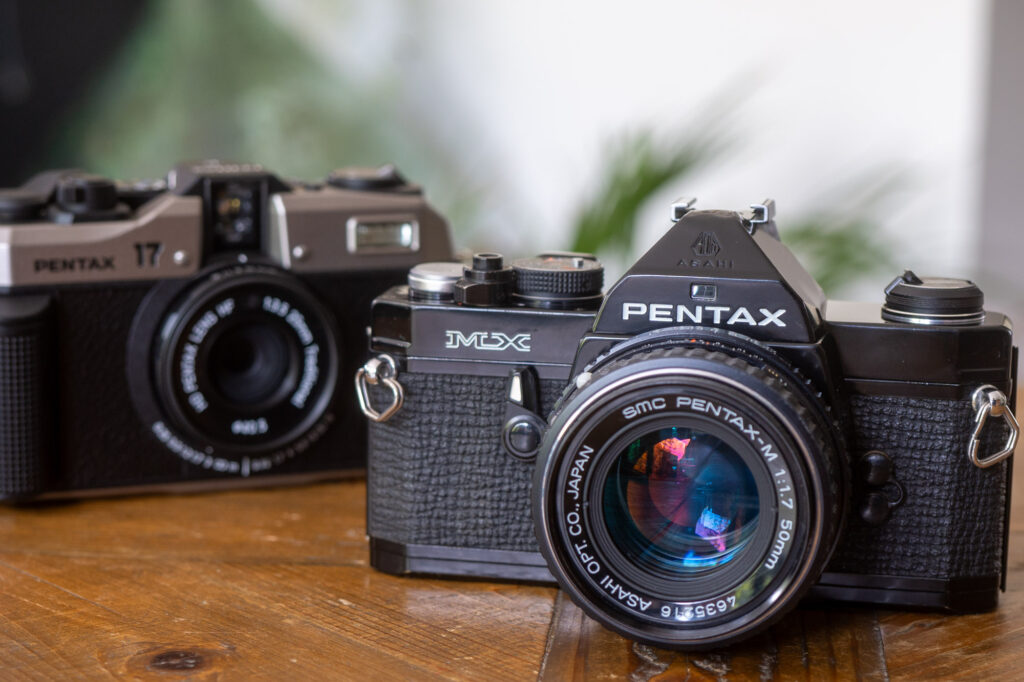
The Pentax 17
Ok, preamble done… It’s time I told you about the Pentax 17. Let me kick off by saying I think Pentax have managed to pull off something of a unique film camera. I can’t think of anything that has this particular set of specs and shooting options.
Features & Specs
The first thing to note about the Pentax 17 is that is a half-frame camera. In a world where film and developing costs are getting higher, doubling the potential shot count per roll doesn’t feel like a bad shout. The lens is a 25mm f/3.5, giving it an approximate equivalent field of view and depth of field to a 35mm f/5 lens on a full frame camera.
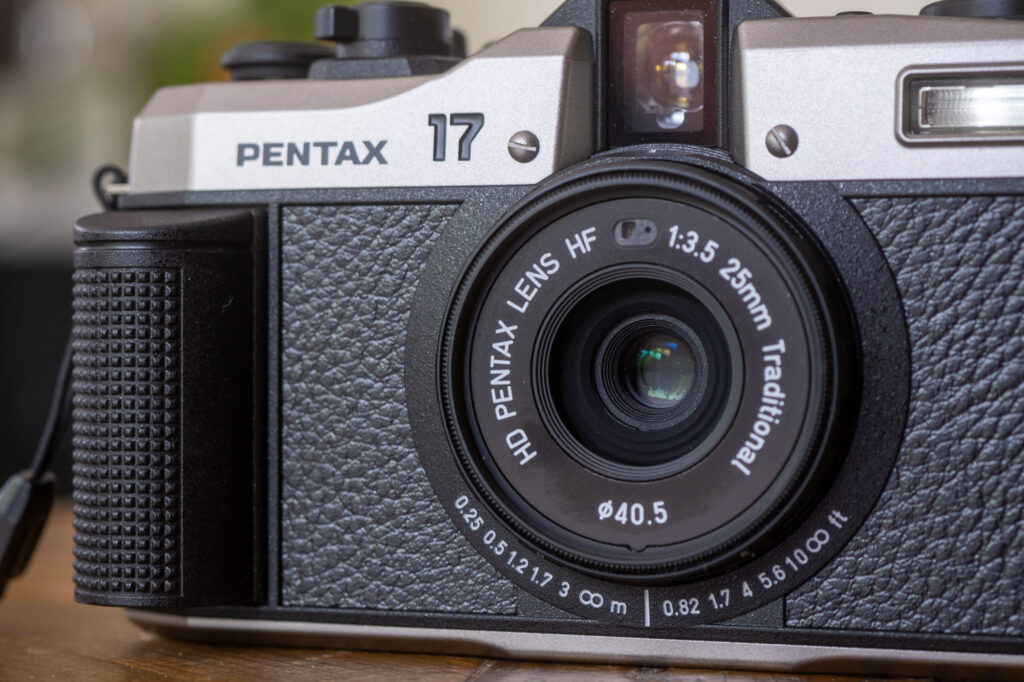
The lens is manual focus only, with click stops at the focus distances indicated via a set of fairly familiar symbols. These symbols are visible on top of the lens as well as through the viewfinder. I say “fairly” familiar as the flower for macro, different sized people and mountains are all symbols I have seen on cameras before. I am not sure I have seen the knife and fork for the close-up distance between macro and portrait though – a sign of times where it has become popular to photograph one’s dinner, perhaps? Focus distances are also indicated below the lens in both meters and feet. With the 25mm f/3.5 lens, it should be pretty easy to focus, even at closer distances.
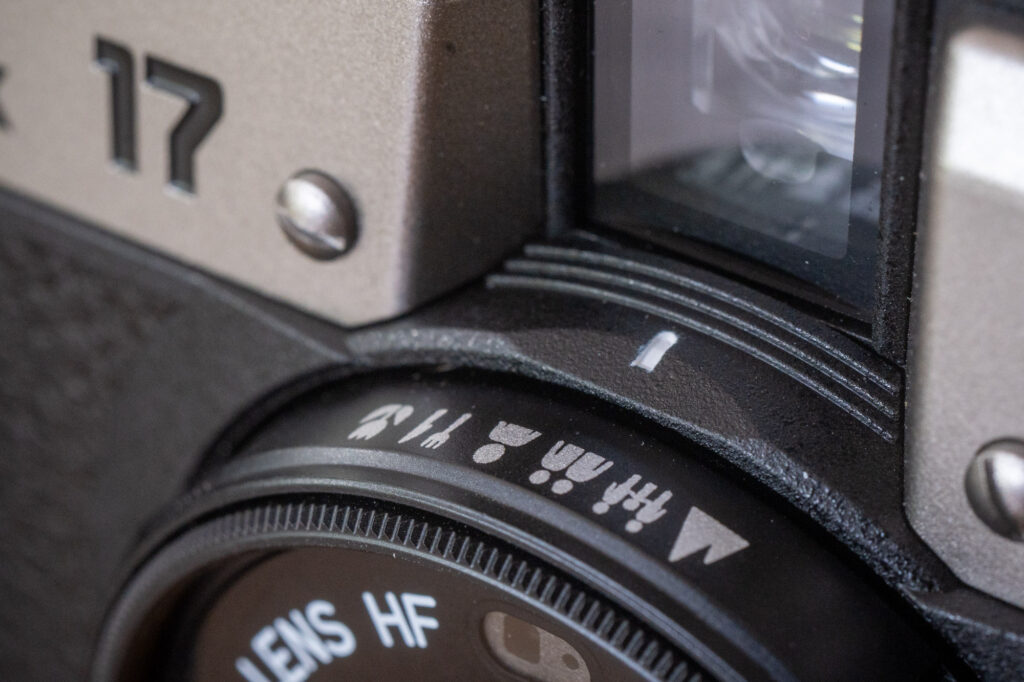
The Pentax 17 Camera Body
The majority of the Pentax 17, including all the controls and dials is made of plastic. The top and bottom plate appear to be made out of metal – the material certainly feels slightly colder to the touch, though it’s quite hard to tell these days. The overall feel of the camera is pretty solid, albeit slightly hollow feeling in places, though I don’t hold that against it. It feels like a fairly well built consumer-level camera.
The design of the Pentax 17 is quite interesting too. It’s quite small, but it’s not small pocket-camera small. The body is a bit smaller than a small SLR, though bigger than a lot of point & shoots. It’s probably most comparable to early point & shoot cameras from the 80s (such as the Canon above). Fortunately, the lens projects less than a centimetre off the camera which helps it feel smaller. The grip is deeper than the lens, but about the same with the lens cap fitted. The grip also holds the single CR2 3v battery.
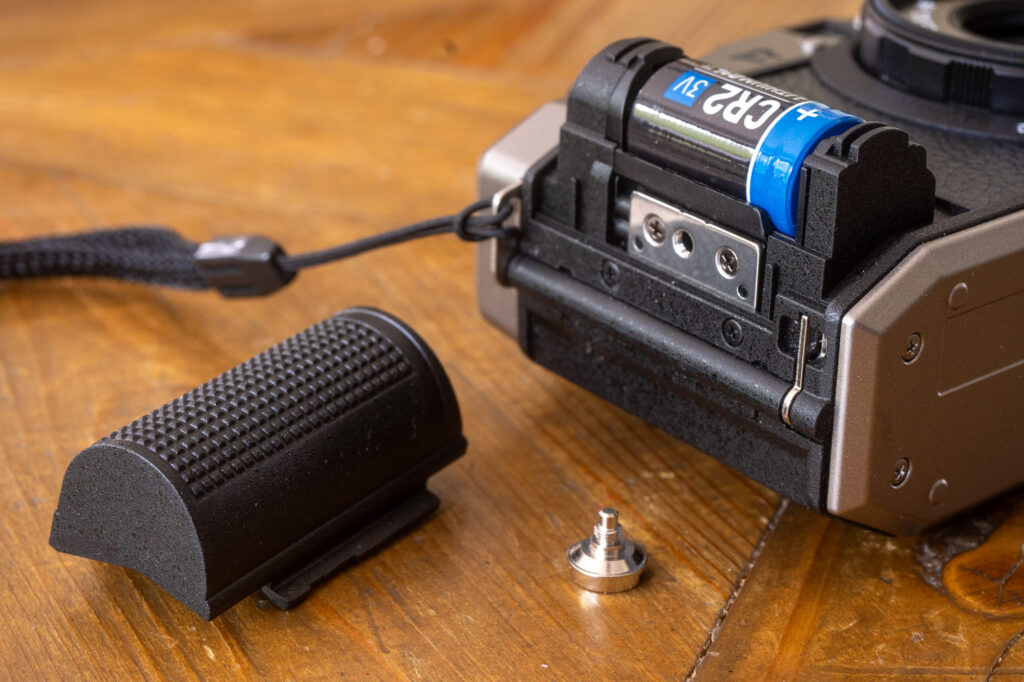
It’s worth noting I think that the little screw that holds the battery compartment closed isn’t fitted to the plastic cover, i.e. if when you unscrew it, it comes all the way out – I can see a few of these getting lost. The cap is a nice Pentax branded pinch to release that clips into a 40.5mm filter thread. The receptor for the light meter is also just above the lens meaning it will account for any filters that might be attached in front of it.
There are also 3 strap lugs on the camera. One on the left as you hold the camera and two on the right. The nice thing about the lower one on the right is that it is flush to the camera – it just looks neat and is out of the way for people who hang the camera conventionally by the two upper lugs. On the back of the camera there is also a slot for putting the end of the film box into to remind you what’s in the camera.
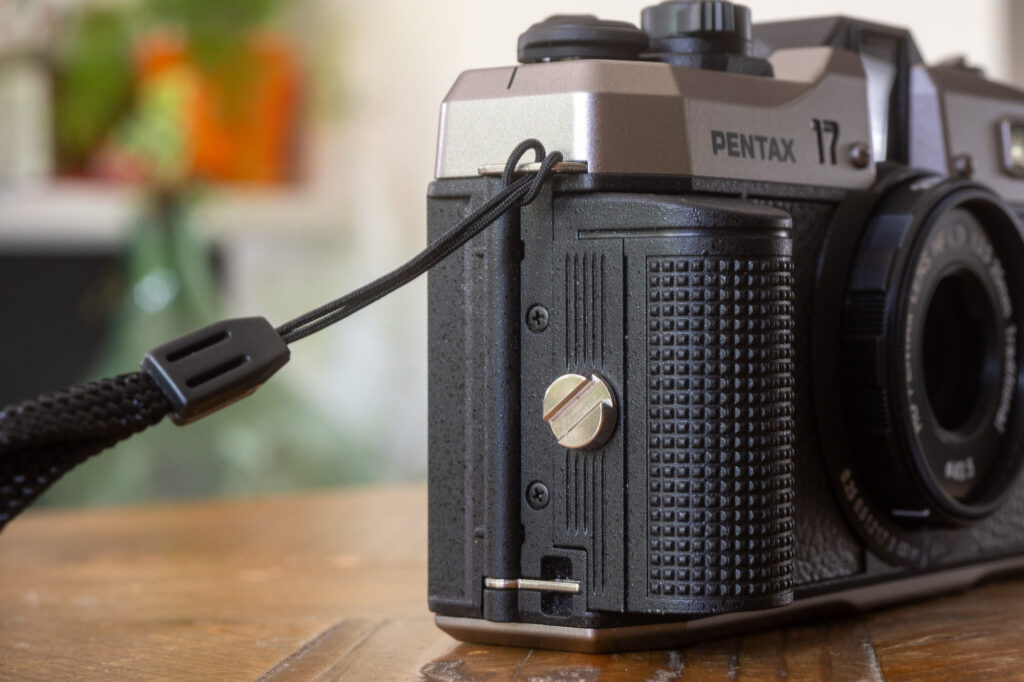
On the top of the Pentax 17 there’s also a set of logos, icons and bits of branding. The Asahi Optical Co. logo at the top above the Pentax logo would have probably been enough of a nod to the legacy, but underneath there’s also “Craftsmanship by Pentax” and “Film Camera” which feel a little cheesy to me. That said, I quite like the design and layout of the logos and words even if I find the wording itself a little redundant. There’s also an icon for indicating the film plane within the camera.
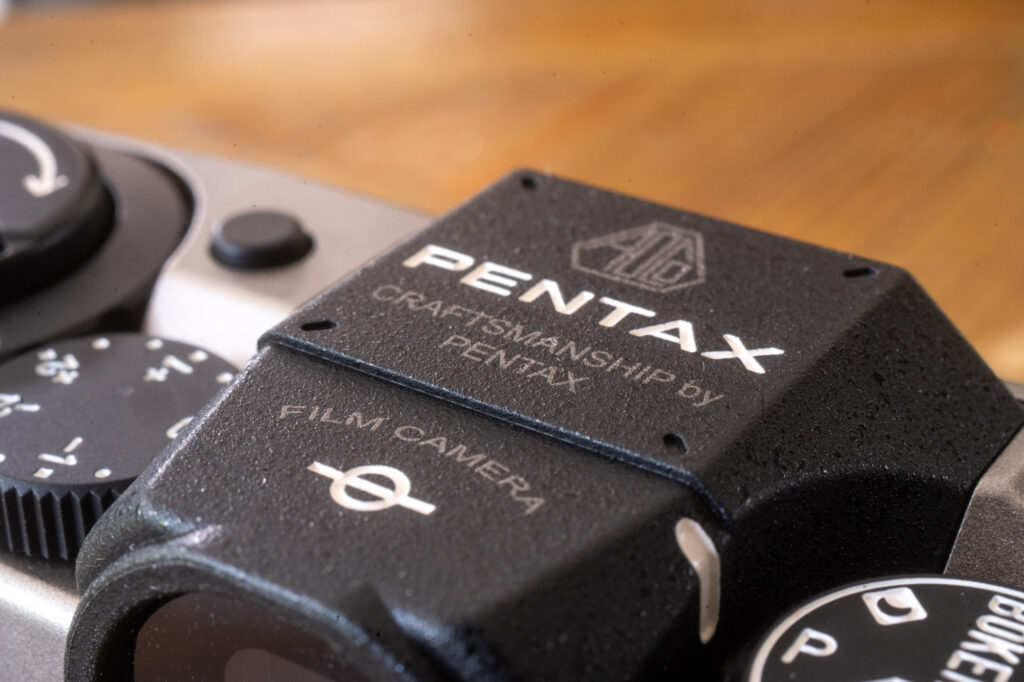
Overall, I think the aesthetic of the Pentax 17 is very nice. It definitely has modern Pentax vibes about it as well as being pretty retro in styling. It also feels really nice to hold and use. It is quite light, and with that there might be a tiny sacrifice in the overall feel of quality – it certainly doesn’t have the solid metal feel of the likes of a Contax T2 – but I don’t think it feels cheap. It’s a nice size in the hand too – the slightly bigger size might come at the expense of it being specifically pocketable, but the 3 strap lugs make up for that in terms of carry-ability. It still fits is a coat pocket or bigger jeans pockets too thanks to the pancake nature of the lens.
The Viewfinder
The Pentax 17 viewfinder is bright and clear – no sign of years of built up dust and haze here. It feels reasonably big to look though, though not massive. Inside the viewfinder, as already mentioned the focus distance is visible at the bottom. Also visible are two sets of framing lines, bigger ones for distance focusing and smaller ones for macro focusing. There’s no moving frame lines unfortunately, just these two, so a bit of guessing at closer-but-not-macro distances is probably going to be required for critical framing. I’ve also found the frame lines to disappear or partially disappear sometimes. You need to have your eye fairly well centred for them to be there, and sometimes given different lighting situations they seem to be less easily visible too. Next to the viewfinder, there are also a pair of LEDs that flash/light up indicating things like the need to advance the film, readiness to shoot, etc.
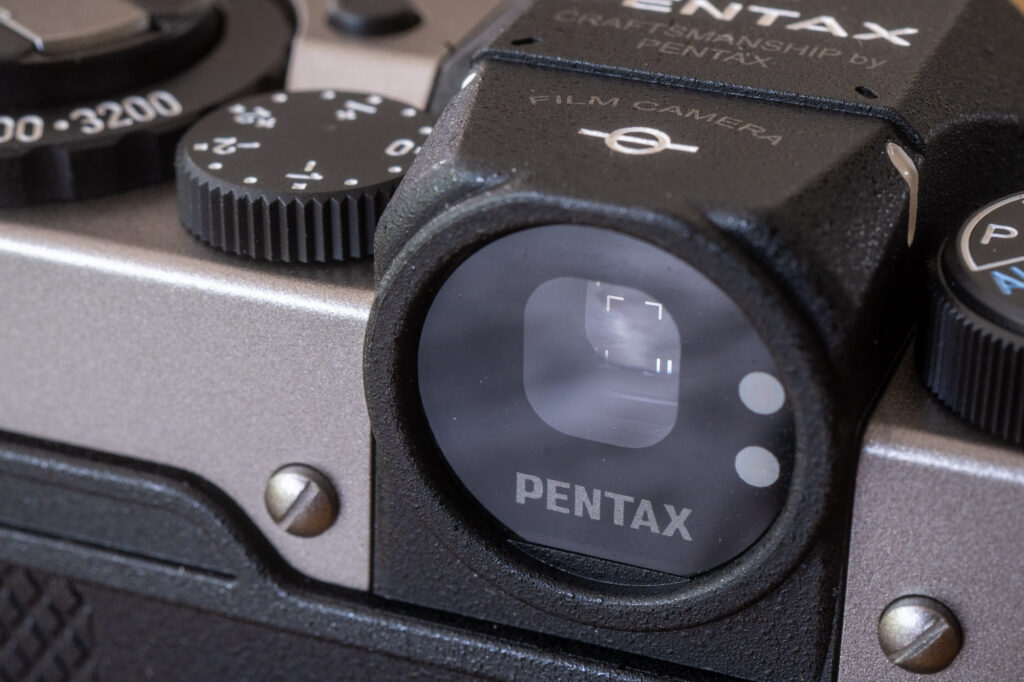
There’s a few different meanings to the various combinations of flashing a illuminated lights, but the most important ones are that he two lights flashing on and off means that you’ve forgotten to advance the film, and just the blue light flashing fast indicates low light. A slow flashing blue light reminds you that the lens is set to one of the close focus ranges. A steady orange light indicates that the flash is ready to fire. One slight frustration I have found with the lights is that they are quite bright. I founds the steady orange light to be very bright in low light situations, almost making the viewfinder hard to see through.
Here’s a snapshot from the manual of the various LEDs – the full manual is available here: pentax17_om_EN

Controls & Dials
Working from the top right looking at the Pentax 17 when it’s in your hand, first there is a shot counter then the manual film advance/shutter cocking lever. The film advance clicks flush with the camera, but also has a second slightly poked-out ready position which quite nicely acts as a little thumb grip when holding the camera.
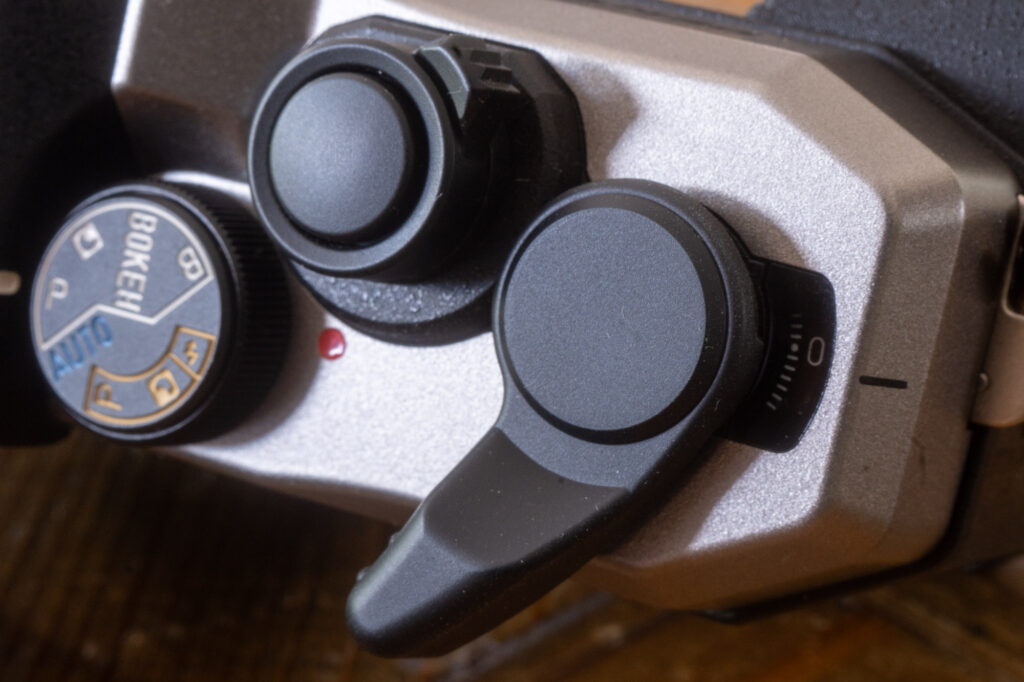
We then have the shutter button which is surrounded by the on/off switch. The Pentax 17 shutter button has a half press which activates the almost silent electronic focusing mechanism and moves the lens to the preset focus position. Remember, this is a manual focus camera, so all that this is doing is setting the focus to the position selected by the user. Half press also sets exposure settings and lights up any relevant LEDs by the viewfinder accordingly. Full press, obviously, takes the photo. The button itself has a pretty nice feel to it, the half press is distinct enough to find it without the risk of an accidental full press. It’s worth noting that half press doesn’t lock exposure either – if you move the camera whilst the button is half pressed, the exposure will adjust according to what the camera is pointed at. There is no exposure lock feature either, though as I will come to, there is an exposure compensation dial.
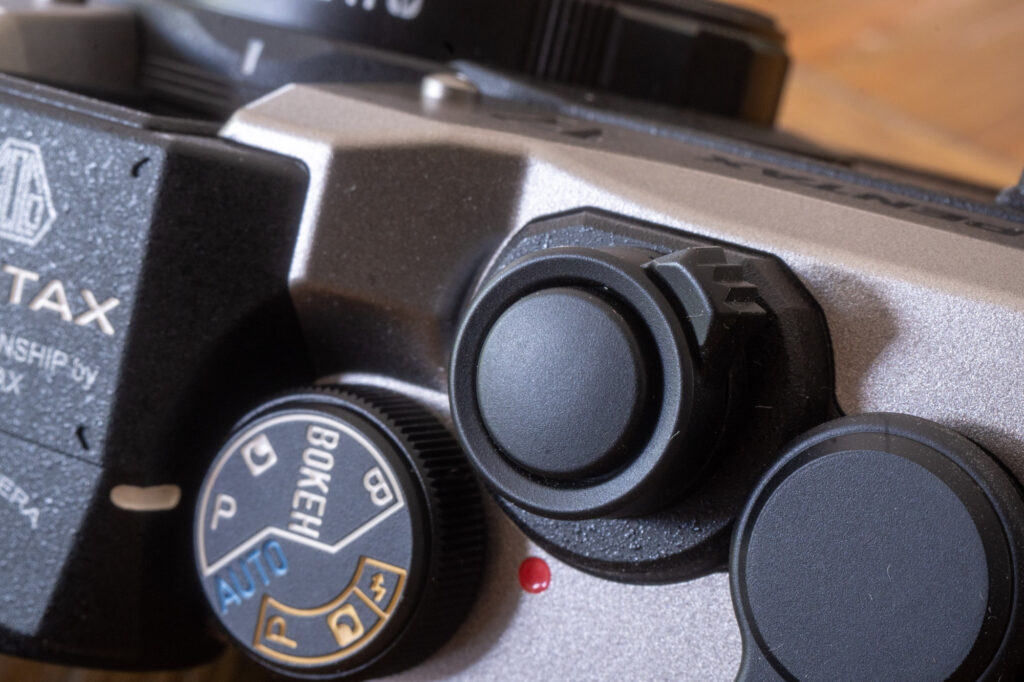
What might be considered slightly unusual is that the manual focus dial doesn’t set the focus manually/mechanically, it just tells the camera what distance/zone to focus the lens to electronically when the shutter is half pressed. Possibly the biggest downside of this system is that it means the camera isn’t what I’d consider a true manual focus camera. The benefit of a true MF camera is that once the focus is set, there’s no shutter lag caused by an AF system having to move the lens into position for correct focus. It could be argued that a manual focus camera that sets the lens after the shutter button is half pressed is almost a worst-of-both-worlds. No AF, but still has shutter lag.
That said, thanks to the lack of AF there’s no processing time – some point & shoots take a moment to decide where to focus which adds to the shutter lag further. At least that isn’t a factor here. I have more thoughts on why the Pentax 17 might work like this in a moment too. I should probably also say that I haven’t yet really noticed the shutter lag in practice. If I think about, it’s there especially at closer distances where the lens moves more, but for normal shooting I don’t think it’s particularly noticeable – you just might notice it if you come to this camera with an expectation of a mechanical manual focus experience.
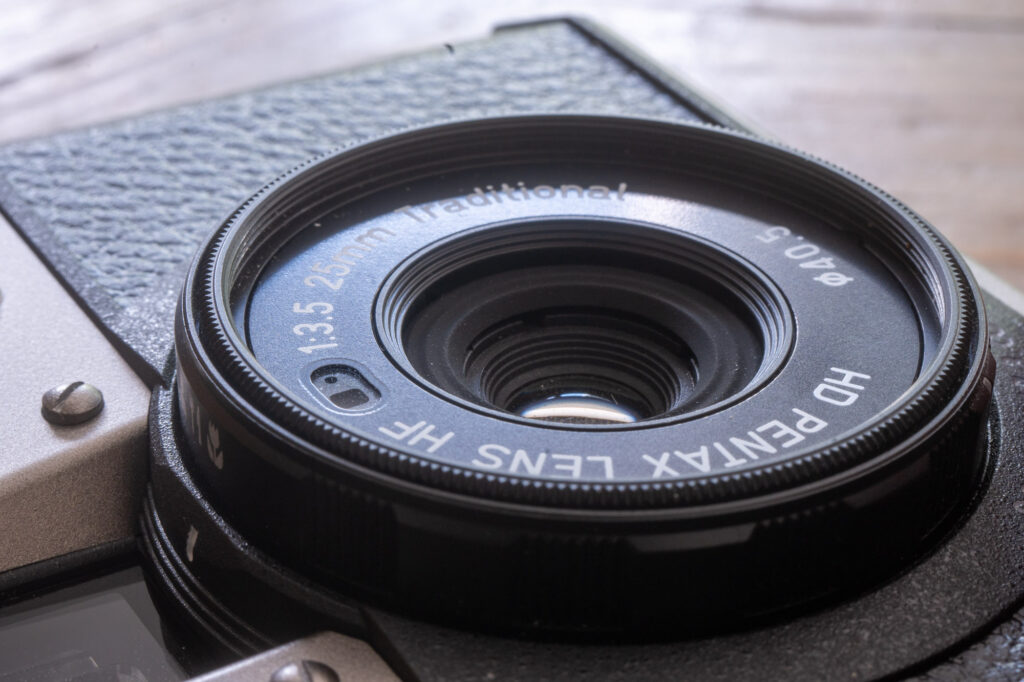
I think it’s also worth pointing out at this stage that thanks to the focusing system being very quiet, and this being a mechanical/manually advancing camera, the Pentax 17 a very quiet/discreet camera to use.
Next we have the control dial with various settings that are all essentially automatic, but provide a reasonable level of control over the decisions the camera makes. First, in blue is the full automatic “auto” mode. Auto is completely automatic and will select an appropriate shutter and aperture as well as firing the flash when the cameras deems fit to (Edit: The auto mode also sets the lens to a fixed hyperfocal distance – it ignores the distance the lens is set to). P for Program sets the shutter and aperture to a balanced setting appropriate for the light levels without it ever resorting to using the flash. The little moon symbol favours longer shutter speeds and “BOKEH” favours wider apertures. B is for Bulb and will keep the shutter open as long as the button is held down. Finally, there’s a pair of flash settings, one for slow sync and one for daylight/fill flash for use when the subject is backlit etc.
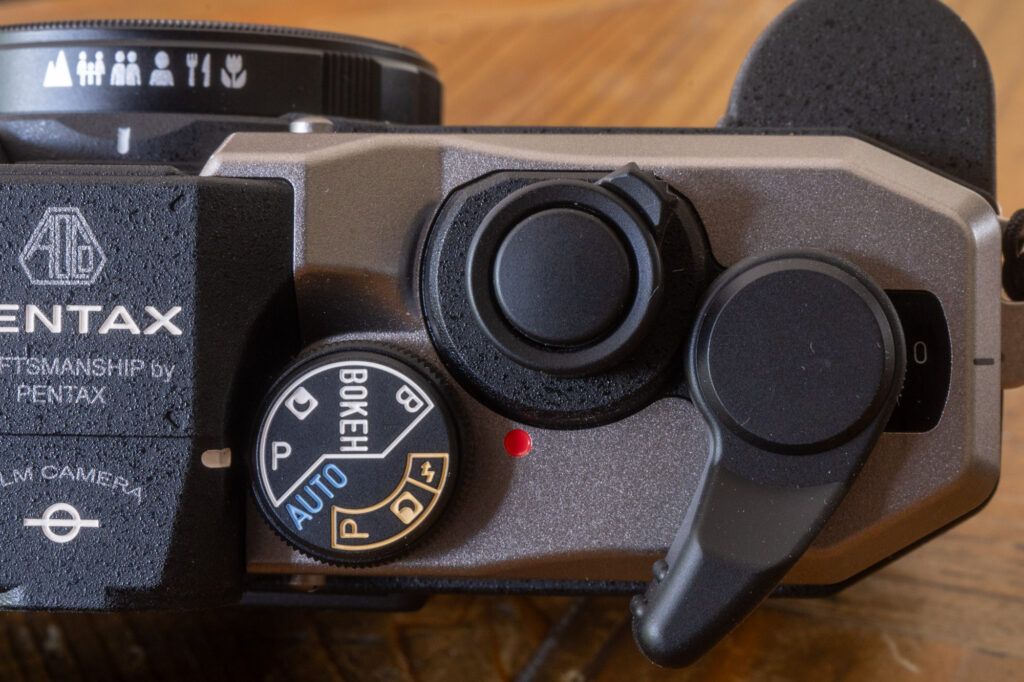
I must say, I’m very impressed by the Pentax 17’s selection of automatic modes. Pentax have managed to fix a few of my biggest gripes with old point & shoot cameras here. First is the fact that the nature of a dial means the camera will retain whatever your shooting preference is. Specifically, if you don’t want the camera to flash after switching it off then on again, it won’t. So few older film cameras offer this as a feature. Next is the three non-flash program settings. When I used to review point & shoot cameras back in the early days of this website, I used to hunt google for program mode settings charts (here is a time I wrote about one). Many point & shoot cameras will favour selecting slightly slower shutter speeds over opening the aperture in slightly low lit circumstances. I found Fuji cameras to be particularly prone to this. The charts would show that the cameras would set 1/30 and f/4 over 1/60 and f2.8 – this baffled me and put me off a lot of Fuji cameras (such as this one). Olympus, on the other hand, used to favour wider apertures. It’s one of the reasons I really liked the mju-ii (despite my reservations about what they cost secondhand).
Pentax have given the wider-aperture program mode the “BOKEH” nomenclature to denote that it will use the widest aperture mode readily and therefore create the shallowest depth of field. How much or little bokeh a 25mm f3.5 lens creates is another matter of course. For me, that’s irrelevant anyway. What’s important here is that we have a wider-aperture-favouring program mode which will reduce the chance of blur in some slightly lower lit circumstances. We also have a longer-shutter-speed-favouring mode for where the opposite is the preference. This might be for either intentional blurring effects (streaky car headlights for e.g.) or for simply helping to ensure larger depth of field for landscapes etc. Given lower-light shooting circumstances, it’s possibly advisable to think about a tripod or something to lean the camera on for this mode. One way or another, these three program modes strike me as being very well thought out, and as I say, I can’t help at being impressed at Pentax for including them.
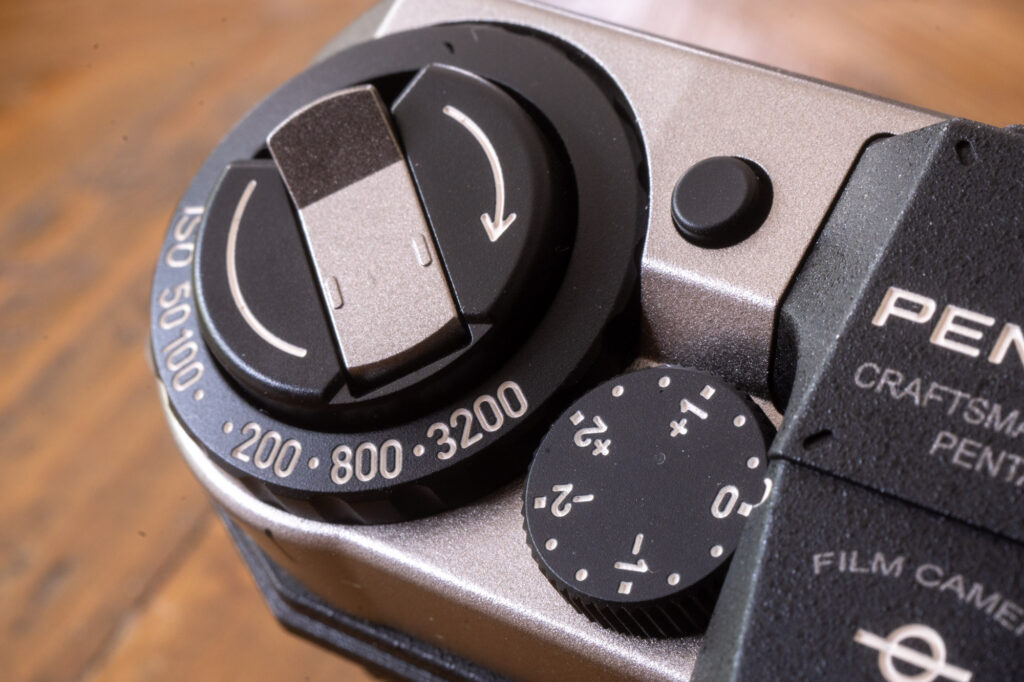
Jumping to the other side of the Pentax 17’s viewfinder and we first find an exposure compensation dial for -2 to +2 compensation. Above this dial is the ISO dial release button which lets the ISO dial to the left rotate for setting between 50 and 3200 ISO. Within the dial is the film rewind which is released via a lock on the bottom of the camera. Pulling the film rewind up pops open the back of the camera. Again, I’m impressed at Pentax for including any level of exposure compensation. Though there is a chance I suppose that those who like to shot some of the ultra-slow films – and/or those wishing to heavily push films – might find the 50-3200 ISO range a little limiting.
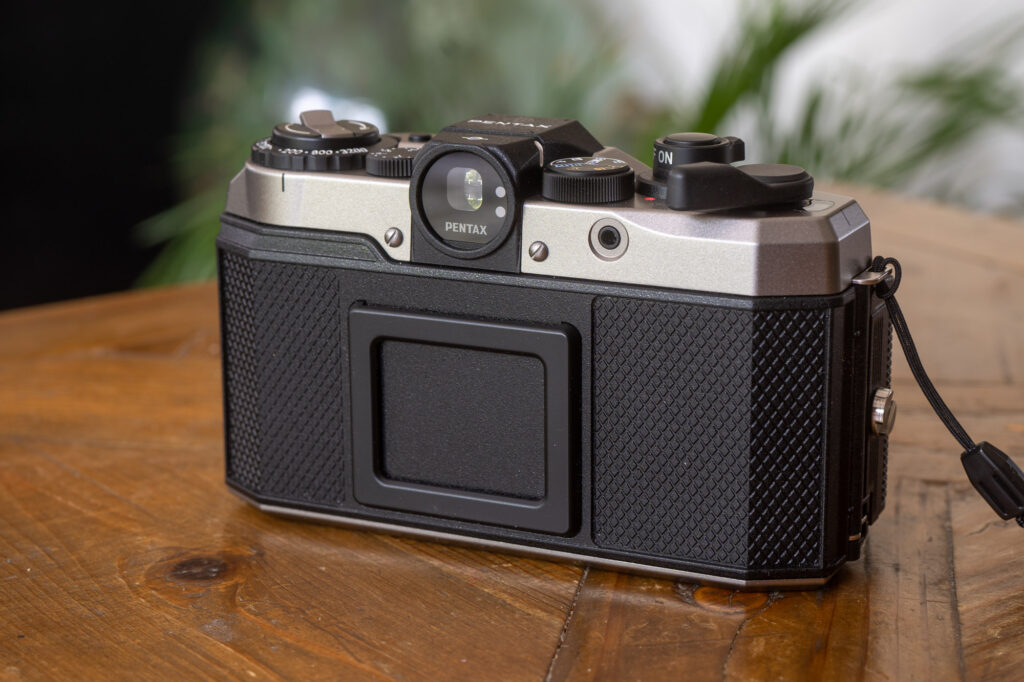
Finally, on the back of the camera, there is also a port for an accessory shutter release as well as the film reminder slot for inserting the end of your film box.
What’s missing?
In some ways it doesn’t feel fair to talk about what’s missing from the Pentax 17 – it’s not even autofocus, so comparing it to the “best” of the point & shoot cameras out there doesn’t necessarily make sense. But, as a camera that’s entering a marketplace alongside some very highly regarded cameras – and with it having such an interesting set of features – I thought it might be an idea to make clear what I think, could by some people, be conceived as missing.
The first thing is something I’ve spoken about already, and that’s the proper parallax adjusting frame lines. This is a feature I’d love to see in a higher spec model, especially one with such close focus capabilities as this camera.
Another thing I think is missing from the viewfinder experience is any kind of digital readout telling the user what shutter speed is going to be used. I took a couple of photos in lower light where I just had to hope there wasn’t going to be motion blur. Admittedly, the flashing blue light on the back gives some indication of low light, but nothing beats a proper shutter speed readout in the viewfinder in my opinion.
There’s also the lack of an aperture control dial. Many of the higher spec point & shoots from back in the day allowed manual control of the aperture. Of course, the Pentax 17 does allow some control in the form of the three program modes. Actually, for me, these offer enough control, but some might disagree.
There’s also a lack of exposure lock. Now it’s very easy to argue that an exposure compensation dial offers a perfectly good alternative to an exposure lock button, but personally I like both. As mentioned, half press doesn’t lock the exposure either.
Finally, there’s no DX code reader. Personally, I probably prefer a lack of DX code reading, especially these days when there’s so many cottage industry films out there that don’t come with a DX code. It does however mean remembering to set the ISO of the film on the camera each time it’s loaded. I guess this will or won’t be an issue depending on the habits of any given individual user. One way or another, I thought it worth a mention.
Pentax 17 Image Quality
So far, I have only developed one roll that I have shot, but I have also been able to have a flick through some of Paul’s (from Analogue Wonderland) photos. It’s really hard not to be impressed by what the Pentax 17 is capable of. Remembering of course that this is a half frame camera, and that my results were all from Ultramax 400, which isn’t exactly at the top of my list when it comes to resolution, I think it’s really impressive!









And here are a couple of Paul’s photos that he kindly allowed me to share
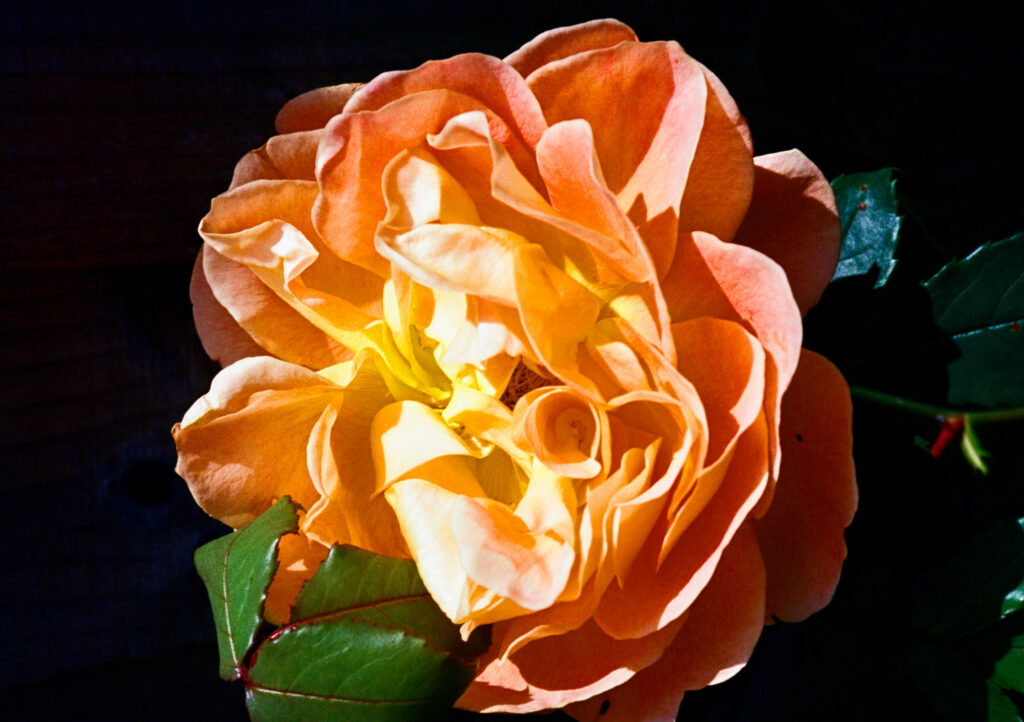
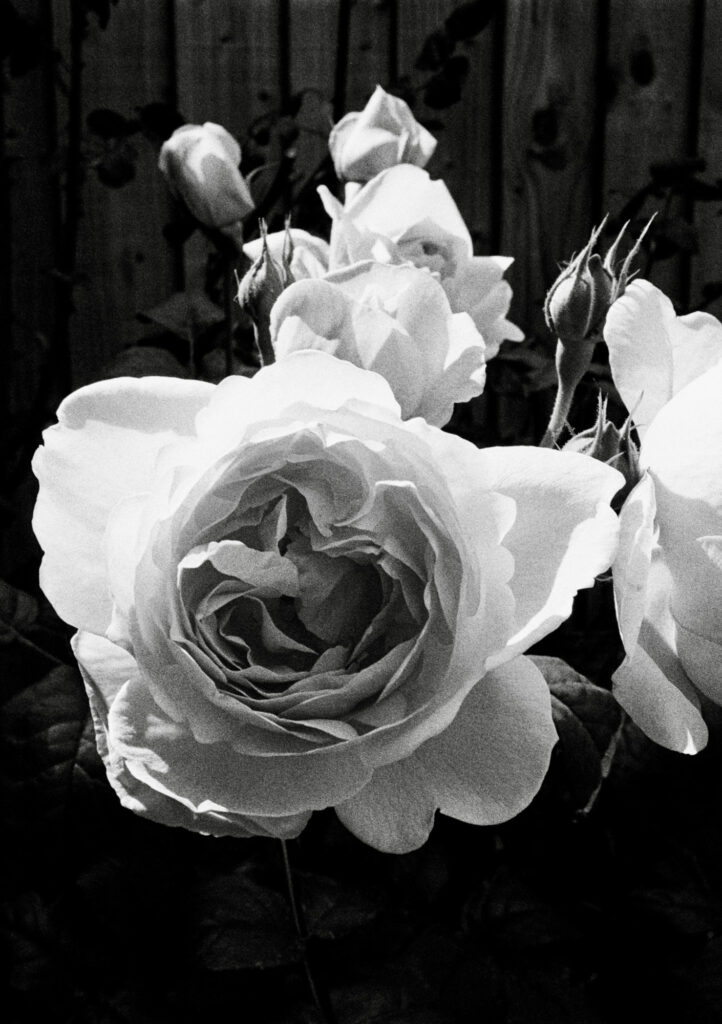

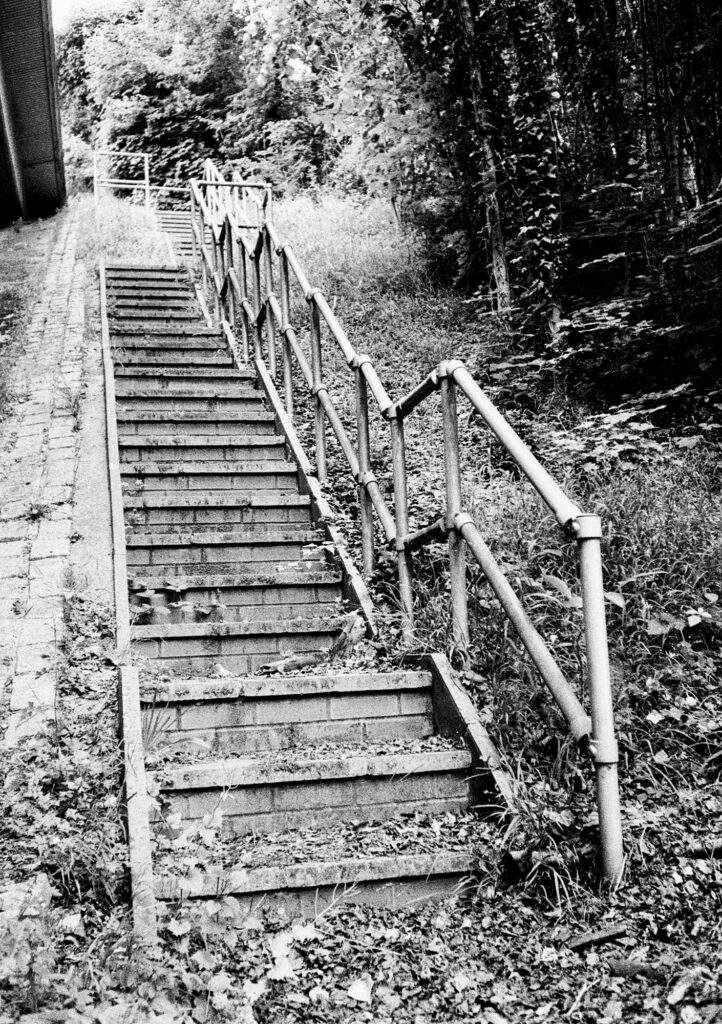

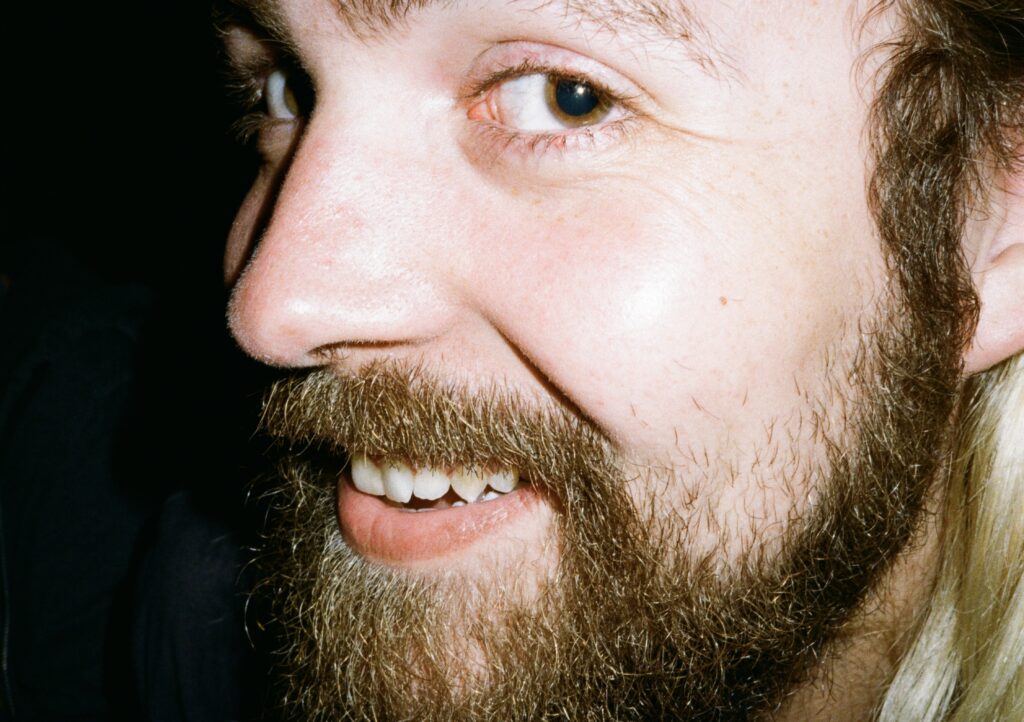
There’s also more of my photos on my flickr here – I have another roll nearly finished, so that will be uploaded soon!
Pentax 17 Key Specifications
I don’t usually share spec lists, but there’s a few key ones I thought worth sharing, as follows:
Frame size: 24 x 17mm (17 being where the camera’s name comes from)
Lens: 3 element/3 group
Lens angle of view: 61 degrees
Filter thread: 40.5mm
Metering range: EV2.5 – 16.5 (ISO100)
Shutter speeds: 1/350th – 4 seconds (and bulb)
Flash guide number: 6
If you would like to see all the specs, they can be found in the manual which I have uploaded here.
Final Thoughts
I think Pentax have done a pretty solid and well rounded job at updating and modernising the concept of the manual focus/manual advance point & shoot film camera. When selecting older film cameras, there has always been a sense that it’s a case of selecting a camera from a series of options that were designed for a by-gone era – even if that by-gone ear was only a decade or so ago. That is to say, with settings options being designed for the marketplace back then, very few cameras seem to offer what a lot of people want from a point & shoot camera today. The result of this is that those cameras that do, have gone up stratospherically in secondhand value.
The Pentax 17 has a really solid and balanced series of features. It answers questions and frustrations that many of us have had with older film cameras such as the ever-frustrating automatic flash modes that need switching off every time the camera is turned on. Impressively, at least to me, it also answers the frustration of the program mode not quite being fit for all uses by having the option of 3 different modes. It’s also quiet, and easy to understand even for the beginner, yet doesn’t feel particularly lacking to someone like me who’s tried a lot of different cameras and therefore is a little more demanding in terms of what features I want to see.
The overall build quality is certainly good enough too, and I can’t help but like how it looks. It seems to strike a fine balance between having a more modern look to it, whilst also appropriately nodding to the its heritage. Though I do retain the right to express a certain level of skepticism at the various cheesy slogans and bits of branding associated with the launch of the camera, and blazoned upon it.
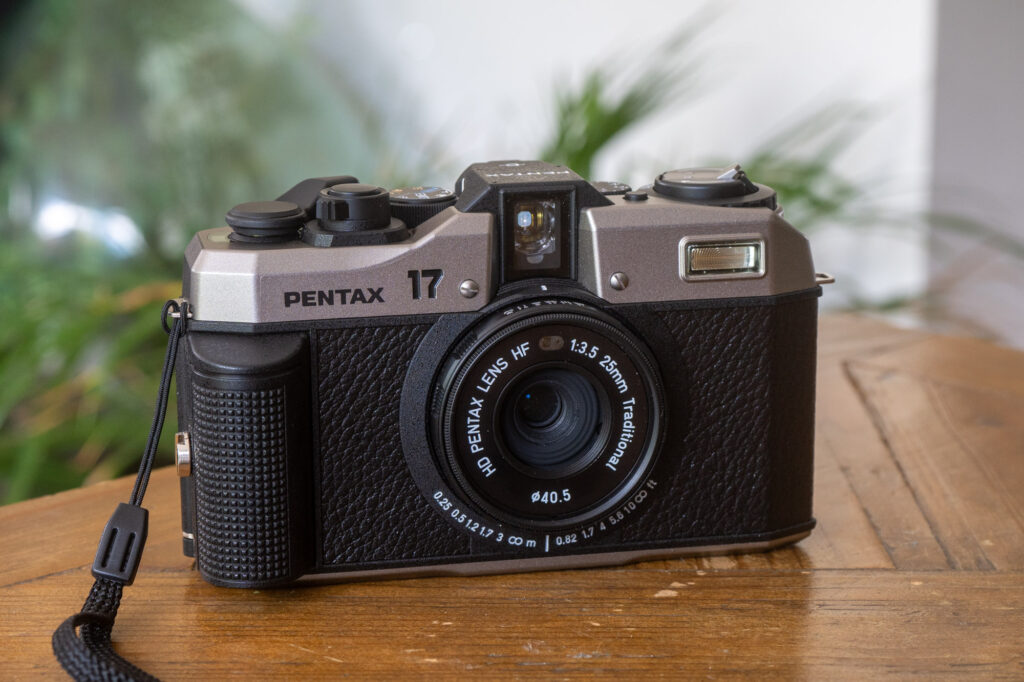
There are of course some limitations too. The viewfinder, whilst bright and big enough, is quite simple. The frame lines being fixed, and having a propensity to disappear sometimes make for a less than perfect framing process. The lack of shutter speed readout might also disappoint some. Though of course, it’s nice to be looking through a clean/bright finder that’s not got years of crap floating around in it. There’s also the slightly unusual electronic focusing that makes for a tiny bit of shutter lag that I wouldn’t expect from a manual focus camera. Though I should emphasise again, that I suspect most people won’t notice this in practice. Of course, it’s manual focus, which will likely limit its appeal to some. There’s no manual controls, DX code reading or exposure lock either. And then there’s the slightly larger size might, and indeed the basic fact that it’s half frame might put a few people off too.
All in all though, I have found myself really enjoying my first week or so with the Pentax 17. I really do belive that what it lacks is definitely outweighed by what it provides. Quite simply, it takes great photos in a way that I’ve found enjoyable to take them, and whilst I can nitpick, none of what I have found lacking has come anything close to being a deal breaker for me. It just feels like a really well thought out camera for a new era of film photographers. It’s also a camera I can see me recommending to beginners without reservation, which has to be a good thing for both those beginners and the industry as a whole. I’m now just looking forward to seeing what Pentax do next, as I believe this camera holds some clues to what we are likely to see.
Hints at what’s to come
The Pentax 17 is interesting in itself, but it’s also interesting in terms of what I think it hints at. Firstly, and perhaps most obviously is the size of the thing. Admittedly, the top plate is fairly crammed and therefore couldn’t be shrunk all that easily with this design and feature set. But, if they actively desired to make a smaller camera, I’m sure they could have made one – especially as it’s half frame. I just don’t think they wanted to make a smaller camera, as by making a slightly larger-bodied camera, they are potentially creating platform of at least some parts that can be shared with other future models. The biggest hint to this is when you open the back of the camera and see the amount of space around the half frame film gate. A few different components here and it could easily be big enough for full frame.
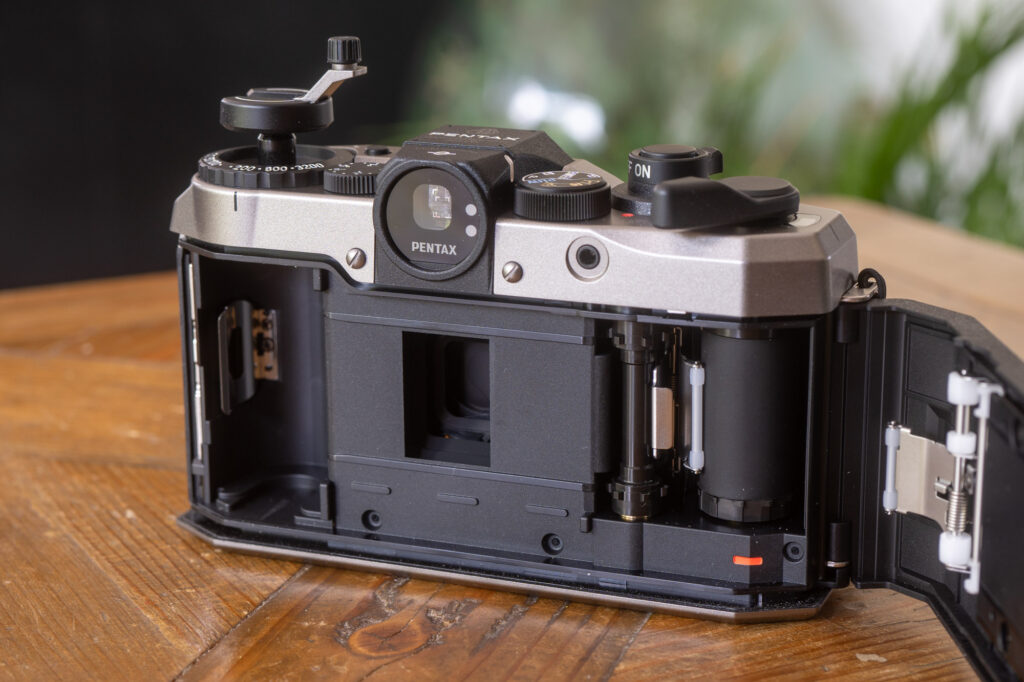
For me though, possibly the bigger hint at what’s to come is the electronically controlled focusing. I’m no camera designer, but if I were making a manual focus camera, I’d probably make one with a mechanically focusing lens. I’m sure it would have been a lot more simple to do so… Unless of course, a design for an electronically focusing camera had already been designed, or at very least needed to be designed for a future camera that needed such a system. It looks to me that the focusing system is based on an AF focusing system that’s been simplified to set distance based on what the focus dial is set to rather than what a AF system tells it to.
In short, I expect we might see a very similar looking camera that’s autofocus, shoots full frame, and sits very comfortably alongside the Pentax 17 in a future line up of film cameras from the brand. Fingers crossed!
If you’re looking to purchase a Pentax 17, you can get one from AW here (this is not an affiliate link).
Share this post:
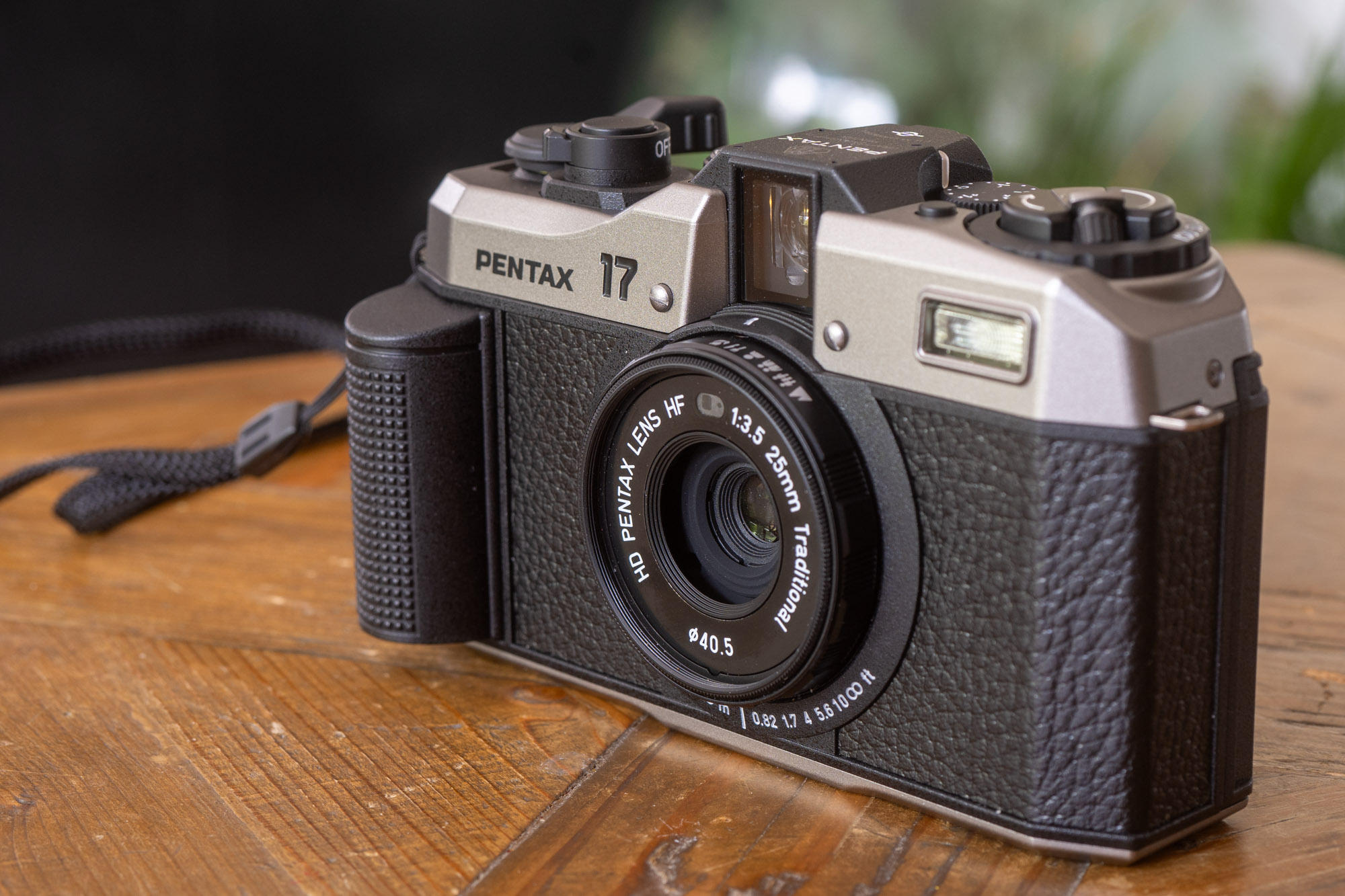
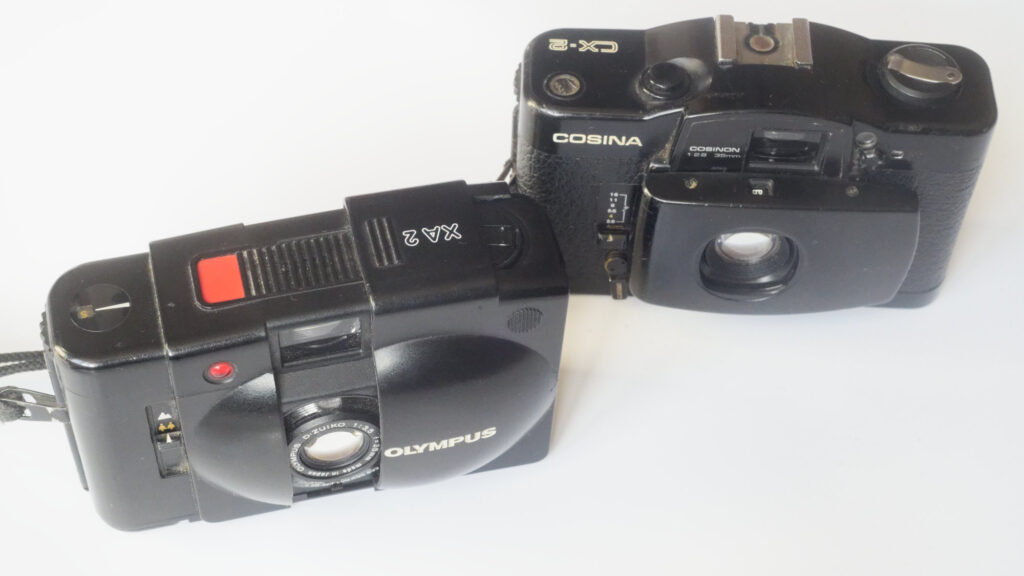
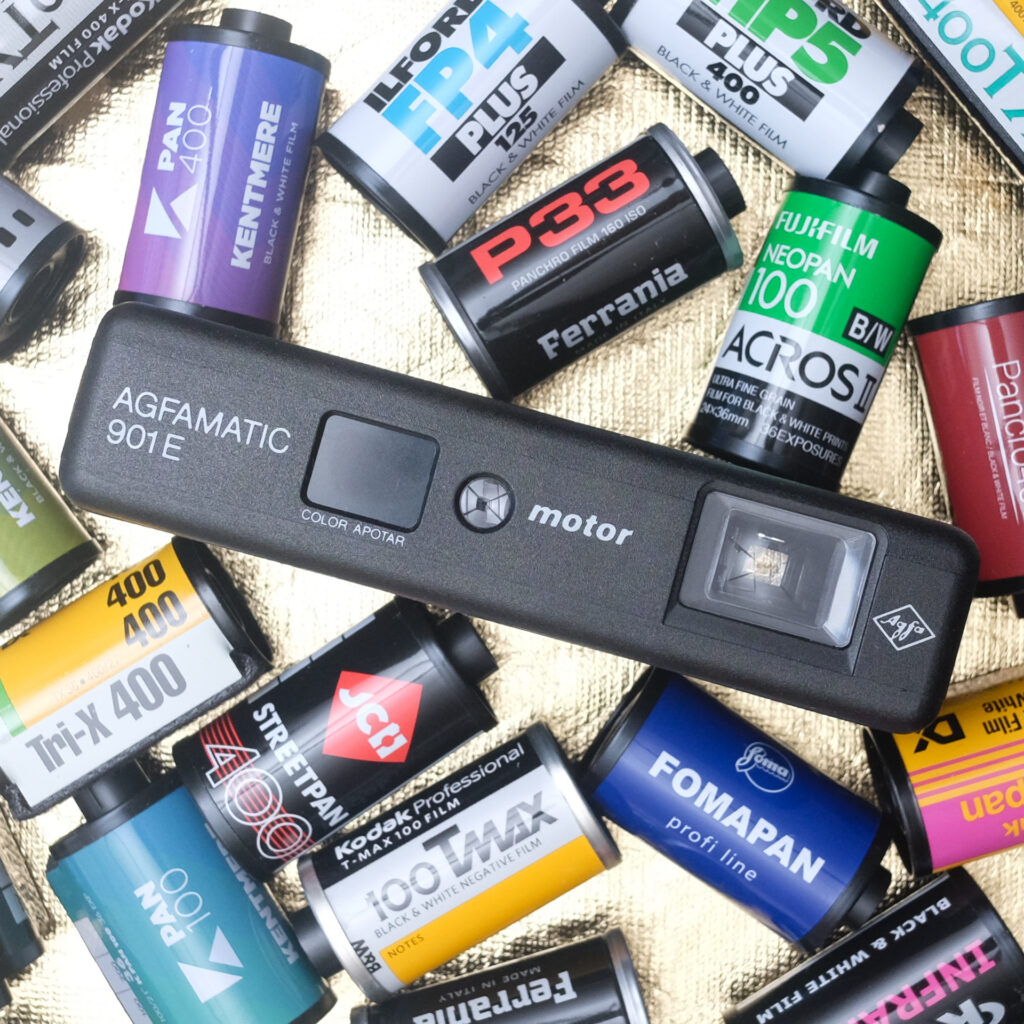
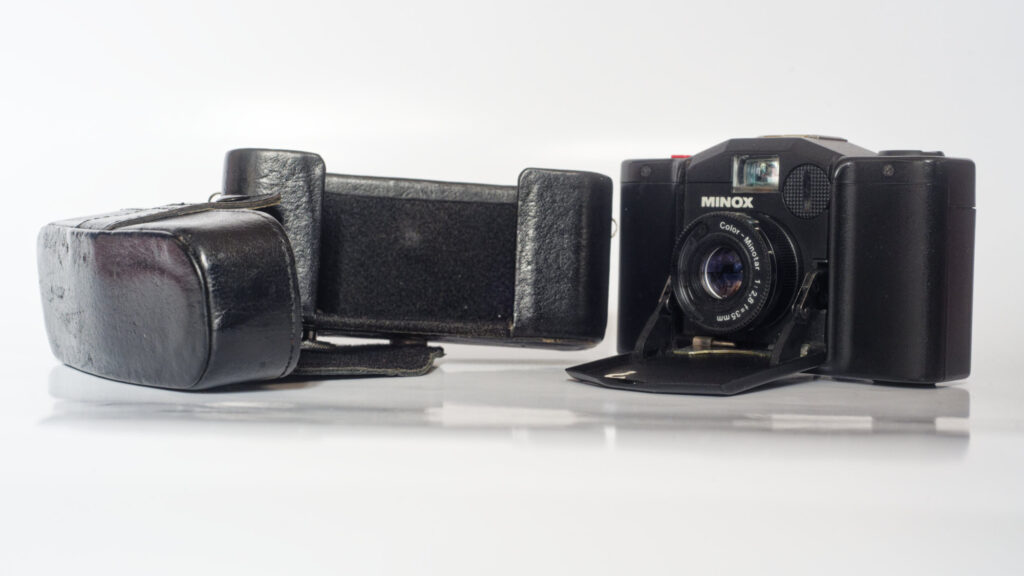
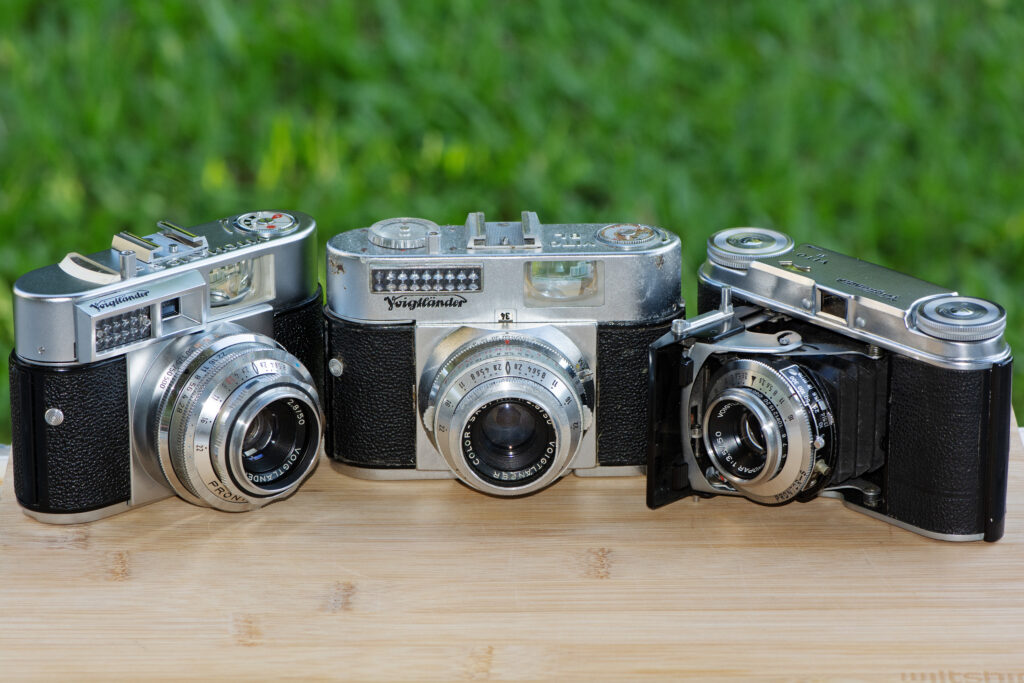




Comments
Kary Schumpert on Pentax 17 Comprehensive Review – The New Half-Frame Point & Shoot
Comment posted: 17/06/2024
Comment posted: 17/06/2024
Jeffery Luhn on Pentax 17 Comprehensive Review – The New Half-Frame Point & Shoot
Comment posted: 17/06/2024
Here are her questions/reaction.
This a film camera that only uses half of a 35mm frame?
Yes.
So grain will be double and sharpness will be cut in half?
Well... kinda... sorta... yes.
And it's not half the size of a normal 35mm camera?
No, it's not.
Does it come in a digital version?
No.
Help me understand why.
Why, what?
Why everything.
There you have it. Wife wisdom. I can't say that I disagree with her. I only hope Pentax makes a ton of money because I like the company and anything that's good for film.
Comment posted: 17/06/2024
Stevenson G on Pentax 17 Comprehensive Review – The New Half-Frame Point & Shoot
Comment posted: 17/06/2024
Well done Pentax I say.
Comment posted: 17/06/2024
Marcus Gunaratnam on Pentax 17 Comprehensive Review – The New Half-Frame Point & Shoot
Comment posted: 17/06/2024
Comment posted: 17/06/2024
Comment posted: 17/06/2024
Comment posted: 17/06/2024
David Hume on Pentax 17 Comprehensive Review – The New Half-Frame Point & Shoot
Comment posted: 18/06/2024
Comment posted: 18/06/2024
Geoff Chaplin on Pentax 17 Comprehensive Review – The New Half-Frame Point & Shoot
Comment posted: 18/06/2024
Comment posted: 18/06/2024
Steve h on Pentax 17 Comprehensive Review – The New Half-Frame Point & Shoot
Comment posted: 18/06/2024
but too much for me. The other is the half moon icon is supposed to mean it’ll lean towards smaller apertures? I gotta wrap my
head around that one. Lastly, hamish I think
right on about this being the platform to ad
onto with subsequent higher featured models.
I noticed it’s use of a cr2 battery when a
couple of double or triple A’s would do fine in its current simple low drain form. But that’s not a bad thing. Even if you shoot many many rolls exclusively with flash, that cr2 will last a good long time. So the next variant will need that battery and there it already is! Smart Pentax!
Comment posted: 18/06/2024
Andy on Pentax 17 Comprehensive Review – The New Half-Frame Point & Shoot
Comment posted: 18/06/2024
Comment posted: 18/06/2024
Eric Norris on Pentax 17 Comprehensive Review – The New Half-Frame Point & Shoot
Comment posted: 18/06/2024
P.S. I preordered one today!
Comment posted: 18/06/2024
Jamie Winder on Pentax 17 Comprehensive Review – The New Half-Frame Point & Shoot
Comment posted: 18/06/2024
HOWEVER! For a particular niche they have absolutely hit this out the park. Last year I spent months researching old half frame cameras to suit a run’n’gun street photography approach. Why half frame? Whilst shallow depth of field is harder to achieve, it means you get more in focus at any given aperture than full frame. Couple this with zone focus and a wide-ish lens and you can shoot freely and almost instantaneously.
Anyway, the criteria for my search had 10 points and not a single camera from the past hit all 10:
1. Half frame
2. Glass lens
3. Wide-ish
4. Zone-focus
5. Auto-exposure
6. Flash-capable
7. Built-in flash
8. Close focus (<0.9m)
9. Non-selenium meter
10. Appealing (subjective, yes)
So, it seems the new Pentax 17 is the ONLY camera in existence that hits every single mark.
Comment posted: 18/06/2024
Phil Snaps on Pentax 17 Comprehensive Review – The New Half-Frame Point & Shoot
Comment posted: 18/06/2024
Also would they go through the difficult process of creating a new wind lever just for this camera? I don't think so.
Comment posted: 18/06/2024
Jack on Pentax 17 Comprehensive Review – The New Half-Frame Point & Shoot
Comment posted: 18/06/2024
Hmmm! What I think Pentax have here, after all the big big fanfare and razzmatazz, is a very big missed opportunity for them to have delivered us an exiting new 35mm film camera which sadly will probably not come again.
Thanks for the excellent review Hamish it was very revealing.
Comment posted: 18/06/2024
Comment posted: 18/06/2024
Bob Janes on Pentax 17 Comprehensive Review – The New Half-Frame Point & Shoot
Comment posted: 18/06/2024
When you consider how simple (ie not a lot to go wrong) the second hand alternatives are (I'm thinking Olympus Trip 35 or one of the little Pens) they look really good value in comparison. The Pentax even makes the Lomo LC-A variants look like a really good deal. On the whole I'd be more inclined to hunt out a nice clean reconditioned Konica C35 or Ricoh G500...
Comment posted: 18/06/2024
Comment posted: 18/06/2024
Comment posted: 18/06/2024
Michael Zwicky-Ross on Pentax 17 Comprehensive Review – The New Half-Frame Point & Shoot
Comment posted: 18/06/2024
Comment posted: 18/06/2024
davesurrey on Pentax 17 Comprehensive Review – The New Half-Frame Point & Shoot
Comment posted: 18/06/2024
Having read a few reviews I believe Pentax have done their research and are aiming clearly at the generation that is used to smartphone photography. Hence the portrait orientation. (I don't buy the cost argument for half frame.) But if this is the case then I feel that lack of DX coding may be a mistake. I also feel that a 35mm EFL lens may not be wide enough for many of this market sector. And they will be used to auto-everything so it’s a brave move by Pentax to force them to have to select focal distance as well as the “type“ of auto-exposure. We shall see.
The first thing I thought when I saw a picture of the camera internals was that this is a full frame camera re-engineered to half-frame. So I agree with Hamish that it will be very easy to make a full-frame version, should this be a success. And again the rather strange way that focus is achieved seems to say that they have a fully auto-focus camera in mind, with little need for re-engineering, re-tooling or new parts. But whether such a beast would appeal to the target market is debateable.
I must admit that I find it cute and in at least one of the shots it reminded me of my Auto 110 from the front and the winder might have come from the Auto 110 parts bin. This could well be the right time for such a camera as successive smartphone releases have less and less to interest a market that thrives on novelty and “the latest” fad.
I find it interesting that all the reviews I have seen so far have been on camera sites and not on smartphone oriented sites. I’d be interested to see what they make of it. Meanwhile I will continue to use some of the very many (too many perhaps) old film cameras I have that have cost me a fraction.
Oh and why is the leaf shutter flash sync set at 1/125?
Hamish: see you at the PhotoWalk on the 29th. Now, which camera to bring???
Comment posted: 18/06/2024
Ibraar Hussain on Pentax 17 Comprehensive Review – The New Half-Frame Point & Shoot
Comment posted: 18/06/2024
I’ve been so excited about this and I think Pentax have a winner on their hands
An all metal body would’ve zoomed the price up.
It looks Great and looks modern and Pentax I think are worth supporting for this move.
And the photos are lovely. Shaper contrasty and just fantastic
They did say, in a recent interview, that a couple of other camera manufacturers will also join them in releasing film cameras !
I was wondering how the film advance lever action and sound is like?
Thanks again
Comment posted: 18/06/2024
Mike on Pentax 17 Comprehensive Review – The New Half-Frame Point & Shoot
Comment posted: 18/06/2024
I do wish someone would bring out a simple fixed MF prime lens digital camera like this, with optical viewfinder and something like a focus confirmation dot in the VF display. Like a non-RF variation on the Pixii.
Comment posted: 18/06/2024
Comment posted: 18/06/2024
Comment posted: 18/06/2024
Comment posted: 18/06/2024
Comment posted: 18/06/2024
Comment posted: 18/06/2024
Patrick Perroud on Pentax 17 Comprehensive Review – The New Half-Frame Point & Shoot
Comment posted: 18/06/2024
It uses a similar AF zone system as the Pentax 17, but its max shutter speed is 1/250 against 1/350, its max iso is 400 against 3200 and its lens (28mm f/2.8 against 25mm f/3.5) sharpness is poor. I shot about 6 rolls a year with this camera, for many years. I will buy the Pentax 17 not only because it will be a very nice upgrade from my 50-year-old Canon Dial 35, but also because I should be able to turn it back in the correct direction, toward the open world outside.
Comment posted: 18/06/2024
fleetwoodler on Pentax 17 Comprehensive Review – The New Half-Frame Point & Shoot
Comment posted: 18/06/2024
I am feeling very disappointed to be honest. This is not a camera made for enthusiasts, like most of the people here clearly are, but rather targeted the "next generation" of film shooters. We kept film painfully alive just for them selling a new camera to Instagram kids. WOW. Also, will those kids buying a zone- focusing system for 550€ as entry point into photography?
As much as I want to support the good cause, for this price I can get well- working top- notch analogue equipment, which is not plastic crap, (either cameras or glass) or rather use the money to support the likes of ORWO and Ilford to make new film.
Comment posted: 18/06/2024
Comment posted: 18/06/2024
Mark Ellerby on Pentax 17 Comprehensive Review – The New Half-Frame Point & Shoot
Comment posted: 18/06/2024
I'm pleased that they went with old-school battery power and weren't tempted to include a proprietary Li-ion battery and a USB-C charging port.
If they make a full frame camera out of this design, I might be tempted. The reality is though, there are a lot of excellent second hand small film cameras available for less than £500, so it would have a lot of competition.
The fact that Pentax have brought this to market bodes well for the future film cameras, so they deserve praise for this.
Comment posted: 18/06/2024
John Pemberton on Pentax 17 Comprehensive Review – The New Half-Frame Point & Shoot
Comment posted: 18/06/2024
The more I learned about it, the more impressed I am at its potential to be an educational tool for some basic concepts at a relatively young age. Field focus develops the idea that the camera needs to be adjusted for a subject's distance from the lens. The "Bokeh" and "blur" settings plant the seed about what an F-Stop and shutter speed can do. The half frame is presented in the view finder in portrait orientation, like so many kids are used to with their cell phones.
It is a really interesting experiment in customer development and building. Yes, they hope to sell this $500 camera today, but they also want to sell more expensive and advanced cameras to this youth cohort 10-15 years from now.
I think many of the critical comments this camera will receive have nothing to do with it, but rather all the Boomer X-er's who are offended that the world no longer revolves around them. For film photography to survive, it needs to survive beyond the people who engage with it now.
Hand a K1000 to a 14 year old and they will be overwhelmed by the math see it as a chore and lose interest soon enough. Hand this to the same kid and they will make pictures, some of which will make them happy. If they are smitten and curious then they will go further and learn what went into the good ones.
It's not the film camera that the 56 year old me would design and choose for myself now, but I hope it is everything to a group of today's kids that the Minolta Autopak 450e was to me on the day I turned 12.
Comment posted: 18/06/2024
Comment posted: 18/06/2024
Comment posted: 18/06/2024
G on Pentax 17 Comprehensive Review – The New Half-Frame Point & Shoot
Comment posted: 18/06/2024
Comment posted: 18/06/2024
Brent Buchner on Pentax 17 Comprehensive Review – The New Half-Frame Point & Shoot
Comment posted: 18/06/2024
Comment posted: 18/06/2024
Comment posted: 18/06/2024
Huss on Pentax 17 Comprehensive Review – The New Half-Frame Point & Shoot
Comment posted: 18/06/2024
Comment posted: 18/06/2024
Comment posted: 18/06/2024
Andrew on Pentax 17 Comprehensive Review – The New Half-Frame Point & Shoot
Comment posted: 18/06/2024
Stefan Wilde on Pentax 17 Comprehensive Review – The New Half-Frame Point & Shoot
Comment posted: 18/06/2024
I have stumbled into a Pentax 17 release party here in the "Khrome" analogue photography store in Hamburg and got to hold it. This of course is nothing to your fantastic, comprehensive review.
I concluded that this camera probably isn´t for me, but that´s perfectly fine because I believe it´s aimed at a much more interesting audience than myself.
I have a cabinet full of old film cameras and am overequipped for any photographic situation I can think of wanting to be in. I´m not a connaisseur, but I certainly have a rich choice of cameras. Could any new camera possibly please me? Probably not, because whatever the question, my cabinet will provide an adequate answer. If I were asked what I´d desire in terms of improvement on what I already have, I´d be lost. I want mechanical excellence! Simplicity! Optical excellence! Medium format!... Wait, I have all that... I want it to be a Leica M, but without the... you know... price?... Errrrrrrr... If Pentax were trying to please people like me they´d be in a commercially unviable place. Talk to model railway makers, they know all about catering to a conservative, spoilt and aged audience.
Let´s face it, I have some more years to enjoy photography, but I´m certainly not the generation that is this medium´s future. I can´t tell, but I absolutely hope that Pentax have nailed what the new generation want. Pentax have created something I haven´t seen so far and that is exactly what is needed.
I mean, I don´t get why people would want to take pictures of their lunch, even less on film and still less why you would want a focus setting for that. But I do get there seems to be a generation to whom this makes sense. Times move on. I don´t need to move on with them when it comes to analogue photography, but if Pentax wants to sell this camera, they need to.
I so much hope this is a success. Fingers crossed, Pentax!
Comment posted: 18/06/2024
bp_reid on Pentax 17 Comprehensive Review – The New Half-Frame Point & Shoot
Comment posted: 18/06/2024
I like that it’s half frame, there are a lot less usable-without-repair half frame cameras out there and getting one with metering that is even vaguely reliable is an even bigger ask since most have selenium cells.
The only real gripe for me is the speed of the lens, in a half frame of this size it should have been faster.
Comment posted: 18/06/2024
Andrew L on Pentax 17 Comprehensive Review – The New Half-Frame Point & Shoot
Comment posted: 18/06/2024
I find it interesting that the focus-by-wire mechanism is basically what the digital GR cameras have for their snap focus feature, and behaves the same way with the minute shutter lag when driving the focus to the preset distance. In practice on the GRIII I have not noticed any real delay.
All in all, I find myself wanting one, while all along I had told myself that this first, beginner, model is not for me.
Comment posted: 18/06/2024
Peter McGowan on Pentax 17 Comprehensive Review – The New Half-Frame Point & Shoot
Comment posted: 19/06/2024
Comment posted: 19/06/2024
Tom Aspin on Pentax 17 Comprehensive Review – The New Half-Frame Point & Shoot
Comment posted: 19/06/2024
As I middle aged bloke ( and old camera bore) I am definitely not the target market, but I do find myself really wanting one....
Comment posted: 19/06/2024
Dave Roberts on Pentax 17 Comprehensive Review – The New Half-Frame Point & Shoot
Comment posted: 19/06/2024
All the reviews are so very positive about it, and, I get it, its a big thing. Big. For the first time in years, one of the historical companies (lets face it none of us were ever in the Leica field of dreams with the New M6) has produced a new film camera.
But I have noticed all the reviews same similar things - this is reasonably priced, this is a great beginner camera - err? No. it isn't.
Would you really recommend this to a newby as their beginner camera? Be honest now. At $900 dollerydoos here Oz - that ain't no cheap camera, certainly not a camera to recommend to someone just starting their film photography journey.
I want to love it and at $600AUD I would buy. I just can't reconcile the price to the design choices made. For a first camera to market, to be the weathervane of viability for more models, this falls shorts because of eccentric design and pricing choices. Don't get me wrong I hope and pray it sells like fresh cream buns in bakery outside a jenny craig gathering. I just worry that Pentax has Pentaxed itself.
Comment posted: 19/06/2024
Comment posted: 19/06/2024
davesurrey on Pentax 17 Comprehensive Review – The New Half-Frame Point & Shoot
Comment posted: 19/06/2024
There are good reasons for this; it is always with them, it costs no more whether they take one or a 100 shots, in fact it costs nothing, and it allows them to upload immediately to their friends and social groups. This third point seems to be crucial having watched kids and grandkids, even those who have used Instax and even a DSLR, which have been relegated to the cupboard.
So what does the Pentax 17 offer to this grouping? Well it’s another thing to have to carry around, developing and printing/scanning are costly if used regularly, but perhaps most importantly, waiting the time it takes to get the film processed etc as well as to use up all 72 frames isn’t what most of this generation are used to. It’s an immediate world they live in.
I think it’s going to be a tough sell.
Comment posted: 19/06/2024
Comment posted: 19/06/2024
Comment posted: 19/06/2024
Russ Rosener on Pentax 17 Comprehensive Review – The New Half-Frame Point & Shoot
Comment posted: 19/06/2024
However, they are at least 55-60 years old. If one of them breaks the chances of finding someone to fix it is very minimal. Half frame (Technically SINGLE frame if you come from a cinema background) is very appealing given both the current cost of 35mm film and processing. Add to that the massive advances in film technology the last 15 years in terms of grain and resolution and you have an old idea that looks new again.
Your photos made with this new Pentax 17 seal the deal for me. Photography is about pictures. The half frame format fits beautifully onto 4 x 6 inch paper. I hope the '17 takes off and inspires a new generation of film photographers.
Eric on Pentax 17 Comprehensive Review – The New Half-Frame Point & Shoot
Comment posted: 19/06/2024
Jay Dann Walker on Pentax 17 Comprehensive Review – The New Half-Frame Point & Shoot
Comment posted: 20/06/2024
In Australia, with the usual retail markups we are used to in the photo trade, buying a 17 won't leave anyone with much change from AUD $1000. Too rich for my blood, but it may appeal to art/artsy students with cashed-up parents.
Overall my first impression was, it reminded me of my long-ago Olympus PEN half-frame, which I bought used in the mid-'80s and loved until the shutter went belly up and several repair shops told me sorry, no parts available. Now and then I take out a box of slides (usually Kodachrome) I shot with this little beauty, and marvel at the quality. I never did make any big enlargements from my B&W negs taken with it, tho'. That may have been a reality check...
I like the ergonomics, sort of. On the whole, the rest of it leaves me somewhat, well, underwhelmed. Shutter speeds are too slow. Many will balk at an f/3.5 lens, tho' after a lifetime of working with Rollei TLRs for me that's not a concern. Too many settings for my liking, I happen to dislike most Fuji digitals for this reasons, film simulations or let's play toy settings were never me. My goals are always to get good street images in the 1950s gritty Tri-X style, not play with Disney colors or cute B&W filter effects.
The half frame may well be its best selling point. At least in Australia where the cost of film and processing are now ultra high, and have driven many of us out of film and into the 'd' world of same-same images. Ditto darkroom supplies, and as for equipment, like buying even a secondhand quality enlarger, well, forget it!
All this written, I've not yet entirely lost interest in maybe acquiring one of these beaut babes. At home in my film fridge I have about 100 rolls of mostly B&W that I want to use up once and for all. I've made quiet plans to take one film camera and this film to Asia with me in December, and have it processed in Singapore and Malaysia where there are still a few film labs in business. Where I stay in Indonesia, fortunately a friend has a B&W darkroom, long unused, which I can expropriate for my B&W processing tho' the problem here may be finding chemistry. I'll have to check Jakarta sources online for this as nobody in Surabaya or even in Bali now does film of any sort, sadly the good old analog film days in a lot of Asia seem to have long ago vanished.
Best, DANN
Daniel Castelli on Pentax 17 Comprehensive Review – The New Half-Frame Point & Shoot
Comment posted: 20/06/2024
I just don’t understand (might be the times) why so many negative or disparaging comments across media platforms. I stated in another forum that this reminds me in a general way of people opposed to the continuing use of fossil fuel, but they complain when they see wind farms and large solar arrays because it ruins their view. Can’t have it both ways…I for one am glad this happened and can’t wait to see what comes next.
Farside on Pentax 17 Comprehensive Review – The New Half-Frame Point & Shoot
Comment posted: 20/06/2024
The older ones have shot up in price and are now getting old and possibly unreliable, although there are still some repairers who take them on (like Luton Cameras).
The price of this one is probably more than I'd like to pay, but in a couple of years I might get a two year old one, that will be nothing like as worn out as its fifty-year-old counterpart. Win-win.
LJ de la Cruz on Pentax 17 Comprehensive Review – The New Half-Frame Point & Shoot
Comment posted: 21/06/2024
Jeffery Luhn on Pentax 17 Comprehensive Review – The New Half-Frame Point & Shoot
Comment posted: 22/06/2024
Dave Powell on Pentax 17 Comprehensive Review – The New Half-Frame Point & Shoot
Comment posted: 22/06/2024
Yes, half-frame was once considered lower quality until cameras, lenses and film advanced to the point where higher-quality images became possible (the Pen F still sets a standard). And still-smaller 110/16mm photos were thought to be worse (though today, stunning images are possible with better emulsions... especially high-res microfilm).
However, one doesn't often hear complaints about "low-quality" Micro-Four-Thirds digital images. That's because those modern systems and lenses are so good. But old 110 and 16mm cameras have about the same frame size as Micro-Four-Thirds digitals! And loaded with modern emulsions, even Kodak's original Pocket Instamatic 60 could conceivably produce a higher-resolution image than a Micro-Four-Thirds DSLR.
That is, of course, comparing apples to oranges. But a film negative of any size could theoretically achieve a higher resolution than a digital sensor of the same size. That's because the real resolution achieved by film depends on the camera, lens, film and development process. But the resolution of a comparably sized digital sensor is fixed at manufacture... and could produce comparatively better or worse results.
And none of the above takes away from the fact that any camera-- regardless of film format or resolution-- can produce lovely, emotive images.
Bill Watts on Pentax 17 Comprehensive Review – The New Half-Frame Point & Shoot
Comment posted: 30/06/2024
Comment posted: 30/06/2024
James Billings on Pentax 17 Comprehensive Review – The New Half-Frame Point & Shoot
Comment posted: 30/06/2024
I won't be immediately rushing out to buy this, mainly as I think the price is quite high (for what you get) and it's more than I can justify on another camera right now - however I absolutely applaud them for making and releasing it and do hope that those who can afford it (and for whom it suits their needs) will pick one up so they continue to invest.
Daz on Pentax 17 Comprehensive Review – The New Half-Frame Point & Shoot
Comment posted: 07/08/2024
I could be wrong but I don't think half press set the the exposure, just the focus.
Comment posted: 07/08/2024